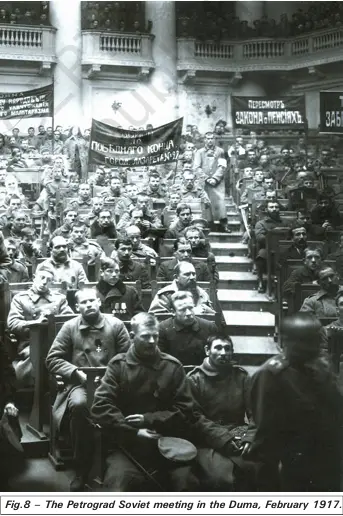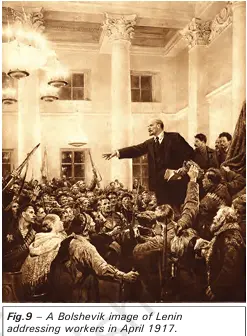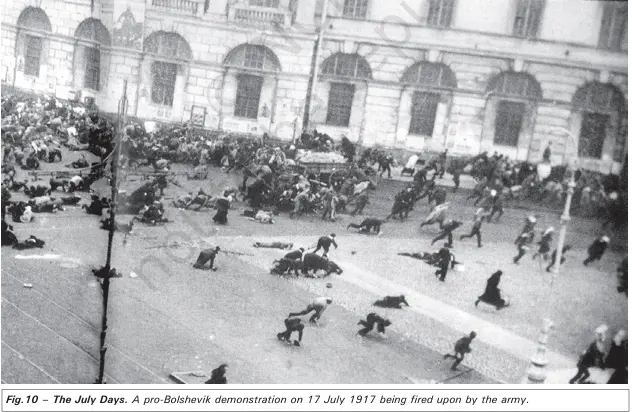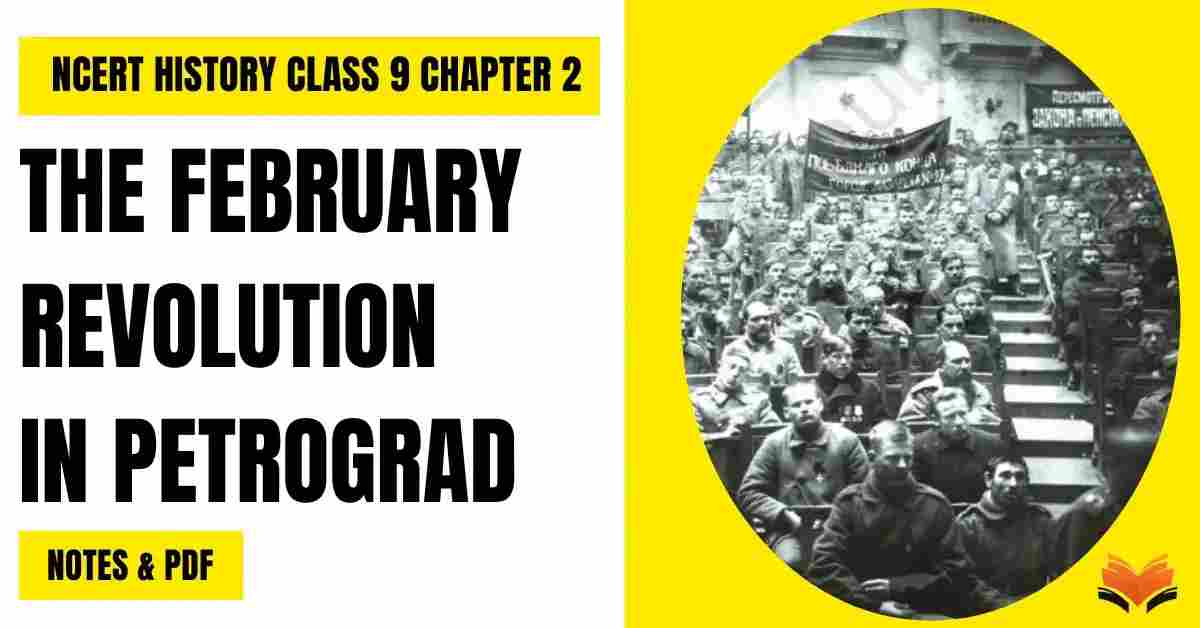The February Revolution in Petrograd – Concept & Notes PDF
Topic & sub-topics covered: The February Revolution in Petrograd and MCQs Questions: Socialism in Europe and the Russian Revolution (All single detail notes are exam-oriented).
We have discussed in-depth and exam-oriented pointers that can be asked in the board exam of class 9th about the “The February Revolution in Petrograd” from the NCERT History notes for class 9th chapter 2nd “Socialism in Europe and the Russian Revolution“.
Download the NCERT History for Class 9th Chapter 2 Socialism in Europe and the Russian Revolution Notes PDF
Looking for clear, concise NCERT notes on Chapter 2: Socialism in Europe and the Russian Revolution? Download the NCERT History Class 9 Chapter 2 Notes PDF and make your revision easier. These notes break down key events, important terms, and timeline-based developments – from the rise of socialism in Europe to how the Russian Revolution changed global politics. Perfect for quick revision before exams, class tests, or just to understand the chapter better. Click to download the free PDF now and study smarter.
The February Revolution in Petrograd

1. Grim Conditions in Petrograd (Winter 1917):
- Petrograd faced severe hardships during the winter of 1917.
- The city layout reflected class divisions:
a. Right bank of River Neva: workers’ quarters and factories.
b. Left bank: Winter Palace, official buildings, homes of elites. - Food shortages were severe in the workers’ areas.
- The winter was marked by extreme cold, heavy snow, and frost.
- Parliamentarians opposed the Tsar’s attempt to dissolve the Duma and wanted to preserve elected governance.
2. Start of the February Revolution:
- 22 February 1917: Lockout at a factory on the right bank of River Neva.
- 23 February 1917: Workers in 50 factories went on strike in support.
- Women workers led many of these strikes, giving rise to International Women’s Day.
- Workers crossed over to the Nevskii Prospekt – the city centre.
- At this point, no political party was actively leading the protests.
- Government responded with curfews; demonstrators dispersed in the evening but returned on 24th and 25th.
- Police and cavalry were deployed to monitor the unrest.
3. Climax of the Revolution:
- 25 February (Sunday): The Duma was suspended by the government.
- Politicians opposed this move; demonstrations intensified on 26 February.
- 27 February: Protestors ransacked Police Headquarters.
- Massive protests broke out demanding:
a. Bread
b. Better wages
c. Reduced working hours
d. Democracy - Government again deployed cavalry, but they refused to fire on the crowd.
- In a turning point, three regiments mutinied and joined the protestors.
- A soviet (council) was formed by workers and soldiers in the same building as the Duma—this was the Petrograd Soviet.
4. Fall of the Monarchy:
- On 28 February, a delegation met Tsar Nicholas II.
- Military commanders advised the Tsar to abdicate.
- Tsar abdicated on 2 March 1917.
5. Formation of the Provisional Government:
- After abdication:
a. Leaders from the Soviet and the Duma formed a Provisional Government.
b. It was agreed that Russia’s future would be decided by a Constituent Assembly elected through universal adult suffrage. - Petrograd led the February Revolution that successfully brought down the Russian monarchy.
Women in the February Revolution
1. Role of Women Workers:
- Women workers played a crucial role in initiating and inspiring revolutionary actions during the February Revolution.
- They often influenced and motivated their male co-workers to join strikes and protests.
- Example: At the Lorenz telephone factory, a woman worker named Marfa Vasileva played a key role.
2. Marfa Vasileva’s Leadership:
- On the occasion of International Women’s Day, women workers gave red bows to male workers—a symbol of unity and protest.
- Marfa Vasileva, a milling machine operator, initiated a spontaneous strike.
- Workers on her floor were ready to support her without hesitation.
3. Bread as a Symbol:
- The foreman informed the management, who tried to bribe her back to work with a loaf of bread.
- She accepted the bread but refused to resume work, showing solidarity with others who were hungry.
- Her powerful quote: “I cannot be the only one who is satiated when others are hungry.”
4. Spread of the Strike:
- Other women workers gathered around her in support, halting their work.
- Eventually, the men joined the strike too.
- The entire factory came to a standstill, and the crowd rushed onto the streets, turning it into a mass movement.
After February

1. The Provisional Government (Post-February 1917):
- Army officials, landowners, and industrialists had major influence in the Provisional Government after the February Revolution.
- Both liberals and socialists in the government worked towards forming an elected government.
- Restrictions on public meetings and associations were lifted, encouraging political activity.
- Soviets, similar to the Petrograd Soviet, were set up across the country, although there was no uniform election system for them.
2. Lenin’s Return and the April Theses:
- In April 1917, Vladimir Lenin returned from exile to Russia.
- Lenin and the Bolsheviks had opposed World War I since 1914.
- Upon returning, Lenin demanded:
a. End of the war
b. Transfer of land to peasants
c. Nationalisation of banks - These demands were known as Lenin’s April Theses.
- He also suggested renaming the Bolshevik Party as the Communist Party to reflect its radical goals.
- Initially, many Bolsheviks disagreed with Lenin, believing Russia was not ready for a socialist revolution.
- However, later developments changed their opinion.
3. Rise of Workers’ and Soldiers’ Movements:
- During summer 1917, the workers’ movement spread rapidly.
- Factory committees formed in industrial areas, questioning factory management by industrialists.
- Trade unions expanded significantly.
- In the army, soldiers’ committees were also created.
- In June 1917, around 500 Soviets sent representatives to the All Russian Congress of Soviets.
4. Reaction of the Provisional Government:
- As Bolsheviks gained popularity, the Provisional Government began losing power.
- It took strict measures to suppress worker movements and Bolshevik influence.
- Workers were prevented from running factories, and Bolshevik leaders were arrested.
- In July 1917, Bolshevik-led demonstrations were crushed, and many leaders had to go into hiding or flee.

5. Peasants and Land Redistribution:
- In the countryside, peasants with support from Socialist Revolutionaries demanded land redistribution.
- Land committees were formed to oversee this process.
- Between July and September 1917, peasants began seizing land on their own.
6. Summary for Quick Revision:
- Lenin’s April Theses became the ideological foundation for future Bolshevik actions.
- Factory and soldier committees challenged capitalist and military control.
- The Provisional Government failed to maintain authority, while peasants and workers gained momentum.
The Revolution of October 1917

1. Background of the October Revolution:
- Conflict between the Provisional Government and the Bolsheviks intensified by late 1917.
- Lenin feared that the Provisional Government might establish a dictatorship.
- In September 1917, Lenin started planning an armed uprising to overthrow the Provisional Government.
- Bolshevik supporters in the army, soviets, and factories were mobilised for the uprising.
2. Events Leading to the Seizure of Power:
- On 16 October 1917, Lenin convinced both the Petrograd Soviet and the Bolshevik Party to support a socialist seizure of power.
- A Military Revolutionary Committee was formed under the leadership of Leon Trotskii to organize the takeover.
- The date of the uprising was kept secret to maintain the element of surprise.
3. October Uprising Begins – 24 October 1917:
- The actual uprising began on 24 October 1917.
- Prime Minister Kerenskii left Petrograd to summon loyal troops, sensing the impending revolt.
- Government forces seized the offices of two Bolshevik newspapers.
- Pro-government troops also attempted to take control of telephone and telegraph offices and secure the Winter Palace.
4. Bolshevik Response and Seizure of Power:
- The Military Revolutionary Committee reacted quickly:
a. Ordered the seizure of government buildings
b. Directed the arrest of government ministers - The ship Aurora shelled the Winter Palace, a symbolic moment of the revolution.
- Other ships on the Neva River took over key military points in the city.
- By nightfall on 24 October, the Bolsheviks controlled Petrograd, and the ministers surrendered.
5. Bolshevik Victory and Aftermath:
- The All Russian Congress of Soviets, meeting in Petrograd, approved the Bolshevik action by majority vote.
- Similar uprisings occurred in other cities, showing wide support for the Bolsheviks.
- There was intense fighting in Moscow, but by December 1917, the Bolsheviks controlled the Moscow-Petrograd area.
6. Summary Box for Quick Revision:
- Key Leaders: Lenin (strategist), Trotskii (organiser)
- Key Date: 24 October 1917 – Bolshevik Uprising begins
- Outcome: Petrograd under Bolshevik control; Provisional Government overthrown
- Symbolic Acts: Shelling of Winter Palace by ship Aurora
- Result: Start of the first communist government in the world
Important dates:
- 1850s -1880s – Debates over socialism in Russia.
- 1898 – Formation of the Russian Social Democratic Workers Party.
- 1905 – The Bloody Sunday and the Revolution of 1905.
- 1917:
a. 2nd March – Abdication of the Tsar.
b. 24th October – Bolshevik uprising in Petrograd. - 1918-20 – The Civil War.
- 1919 – Formation of Comintern.
- 1929 – Beginning of Collectivisation.
Date of the Russian Revolution
1. Calendar Shift in Russia:
- Russia used the Julian calendar until 1 February 1918.
- After this date, Russia adopted the Gregorian calendar, which is used internationally today.
2. Julian vs. Gregorian Dates:
- The Gregorian calendar is 13 days ahead of the Julian calendar.
- This difference in calendars caused a shift in the recorded dates of key revolutionary events.
3. Revised Dates of the Russian Revolutions:
- The ‘February Revolution’ (according to the Julian calendar) actually occurred on 12th March 1917 in the Gregorian calendar.
- The ‘October Revolution’ (Julian calendar) took place on 7th November 1917 (Gregorian calendar).
4. Summary Box for Quick Revision:
- Old Calendar Used: Julian (till 1 Feb 1918)
- New Calendar Adopted: Gregorian
- Difference: Gregorian is 13 days ahead
- Feb Revolution (Gregorian): 12 March 1917
- Oct Revolution (Gregorian): 7 November 1917
Next & Previous Topics of NCERT/CBSE History Class 9 Chapter 2: Socialism in Europe and the Russian Revolution
| Topics No. | Topics Name |
|---|---|
| 1 | The Age of Social Change |
| 2 | The Russian Revolution |
| 3 | The February Revolution in Petrograd |
| 4 | What Changed After October? |
| 5 | The Global Influence of the Russian Revolution and the USSR |
MCQs on NCERT History Class 9 Chapter 2 Topic – The February Revolution in Petrograd
Here are the top exam-oriented MCQ-type questions on “The February Revolution in Petrograd” that you should prepare for your CBSE or state board exams:
Question 1. Where were most factories and workers’ quarters located in Petrograd?
A) Left bank of the River Neva
B) Right bank of the River Neva
C) Nevskii Prospekt
D) Near the Duma building
Answer: B
Question 2. What triggered the February Revolution in Petrograd?
A) Military revolt
B) Closure of the Duma
C) Lockout at a factory and workers’ strike
D) Attack on the Winter Palace
Answer: C
Question 3. Which event coincided with the initial strikes of February 1917?
A) May Day
B) Labour Day
C) International Women’s Day
D) Independence Day
Answer: C
Question 4. Which area did the demonstrating workers march towards during the February Revolution?
A) The Red Square
B) The Kremlin
C) The Winter Palace
D) Nevskii Prospekt
Answer: D
Question 5. When was the Duma suspended by the government during the February Revolution?
A) 22 February
B) 25 February
C) 26 February
D) 2 March
Answer: B
Question 6. What happened on 27 February 1917?
A) Tsar abdicated
B) Duma resumed session
C) Police headquarters were ransacked
D) Russia declared war
Answer: C
Question 7. What was the immediate response of some regiments to government orders during the February Revolution?
A) They attacked the demonstrators
B) They fled the city
C) They mutinied and joined the striking workers
D) They protected the Duma
Answer: C
Question 8. What was the Petrograd Soviet?
A) A group of nobles
B) A temporary military council
C) A workers’ and soldiers’ council formed during the February Revolution
D) An international peace treaty
Answer: C
Question 9. When did the Tsar abdicate his throne?
A) 24 February
B) 25 February
C) 2 March 1917
D) 7 November 1917
Answer: C
Question 10. What form of government replaced the Tsarist regime after the February Revolution?
A) Communist dictatorship
B) Military rule
C) Provisional Government
D) Absolute monarchy
Answer: C
Question 11. Who was Marfa Vasileva?
A) A Tsarist officer
B) A Bolshevik leader
C) A female worker who led a strike
D) A liberal politician
Answer: C
Question 12. What symbolic item did women workers distribute on International Women’s Day?
A) Red flags
B) Red bows
C) Pamphlets
D) Flowers
Answer: B
Question 13. What was Marfa’s reason for continuing the strike even after being offered bread?
A) She wanted better working conditions
B) She demanded equal pay
C) She could not be satiated when others were hungry
D) She wanted a promotion
Answer: C
Question 14. Which groups were influential in the Provisional Government?
A) Only workers
B) Tsarist generals
C) Army officials, landowners, and industrialists
D) Foreign diplomats
Answer: C
Question 15. What major democratic step was taken after the February Revolution?
A) Formation of the Red Army
B) Creation of the Politburo
C) Removal of restrictions on public meetings
D) Withdrawal from World War I
Answer: C
Question 16. What was the April Theses?
A) A peace treaty with Germany
B) Lenin’s declaration demanding end of war, land redistribution, and bank nationalisation
C) The Tsar’s will
D) A speech by Trotsky
Answer: B
Question 17. According to Lenin, what should the Bolshevik Party rename itself to?
A) Workers’ Party
B) Soviet Union Party
C) Communist Party
D) Marxist League
Answer: C
Question 18. Why were many Bolshevik leaders arrested or forced to hide in July 1917?
A) They tried to assassinate the Tsar
B) They supported the Provisional Government
C) Their demonstrations were repressed
D) They declared independence
Answer: C
Question 19. What happened in the Russian countryside between July and September 1917?
A) Peasants migrated to cities
B) Peasants demanded universal suffrage
C) Peasants seized land from landlords
D) Factory strikes spread to villages
Answer: C
Question 20. Why did Lenin want to begin an uprising in September 1917?
A) To establish a monarchy
B) To prevent a possible dictatorship by the Provisional Government
C) To invade Poland
D) To gain control of Moscow
Answer: B
Question 21. Who led the Military Revolutionary Committee that organised the October Revolution?
A) Stalin
B) Trotsky
C) Lenin
D) Kerensky
Answer: B
Question 22. When did the Bolshevik uprising begin in Petrograd?
A) 2 March
B) 7 November
C) 16 October
D) 24 October
Answer: D
Question 23. What was Prime Minister Kerensky’s response to the Bolshevik threat?
A) He surrendered immediately
B) He fled to Germany
C) He left the city to summon troops
D) He joined the Bolsheviks
Answer: C
Question 24. Which ship shelled the Winter Palace during the uprising?
A) Red Star
B) Lenin
C) Aurora
D) Soviet Glory
Answer: C
Question 25. Which two cities did the Bolsheviks control by December 1917?
A) Moscow and Leningrad
B) Petrograd and Moscow
C) Kiev and Warsaw
D) Berlin and Moscow
Answer: B
Question 26. How was the Bolshevik action in Petrograd viewed by the Congress of Soviets?
A) It was rejected
B) It was condemned
C) It was approved by majority
D) It was never discussed
Answer: C
Question 27. Russia used the Julian calendar until:
A) March 1917
B) 1 February 1918
C) October 1917
D) 1 January 1919
Answer: B
Question 28. According to the Gregorian calendar, when did the February Revolution occur?
A) 2 March
B) 24 February
C) 12 March
D) 7 November
Answer: C
Question 29. The October Revolution took place on which date in the Gregorian calendar?
A) 24 October
B) 7 November
C) 1 December
D) 16 October
Answer: B
Question 30. When was the Russian Social Democratic Workers Party formed?
A) 1905
B) 1898
C) 1919
D) 1929
Answer: B
Question 31. When did the Bloody Sunday and 1905 Revolution occur?
A) 1898
B) 1917
C) 1905
D) 1920
Answer: C
Question 32. When did the Russian Civil War begin?
A) 1918
B) 1917
C) 1919
D) 1921
Answer: A
Question 33. What major event occurred in 1919?
A) Fall of Tsar
B) Formation of Comintern
C) Beginning of Collectivisation
D) October Revolution
Answer: B
Question 34. What marks the beginning of collectivisation in the USSR?
A) 1917
B) 1918
C) 1929
D) 1905
Answer: C

